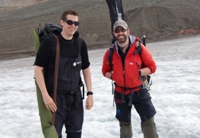Life on glaciers

Report authors Dr Arwyn Edwards (left) and Dr Tristram Irvine-Fynn.
27 November 2013
Scientists at Aberystwyth University have calculated there may be around a septillion (1024 or a trillion trillion) microbes living in the uppermost 2m of Earth’s glaciers.
In fact, there may be as many microbes at glacier surfaces as there are in the top 200m of the world’s oceans.
Drs Tristram Irvine-Fynn (Department of Geography and Earth Sciences) and Arwyn Edwards (Institute of Biological, Environmental and Rural Sciences) have presented revised estimates of microbial abundance in Earth’s glaciers and ice sheets in a paper published online this week in the journal Cytometry Part A.
The paper A frozen asset: The potential of flow cytometry in constraining the glacial biome is available online http://onlinelibrary.wiley.com/doi/10.1002/cyto.a.22411/abstract.
“With around 51 million cubic kilometres of glacier ice on Earth, including Antarctica, this is a major habitat for microscopic life which we know little about” said glaciologist and lead author, Dr Tristram Irvine-Fynn.
“Most of life on Earth is microscopic, and we know there are more microbes on planet Earth than stars in the observable Universe.”
Recently, other scientists have been busy counting microbes living deep below the Earth’s land surface, hidden at depth in the sediments at the bottom of the world’s oceans, and even in the atmosphere and clouds. But until now the icy world has largely been ignored as a home for microscopic life.
Integrating published data from international research groups the two early career researchers at Aberystwyth University calculated the numbers of microbes in the planet’s largest freshwater ecosystem.
Based on published concentrations of microbes in glacier ice up to three quarters of a million years old, the paper suggests between 1025 and 1031 cells may be housed in glacier ice.
“The number of microbes in ice exceeds existing estimates for the number of microbes living in Earth’s unfrozen freshwater lakes and rivers. And, incredibly, this means as many microbes may lie entombed in glaciers as there are in the globe’s rainforest soils.”
However, this is only part of Drs Irvine-Fynn and Edwards’ story: for a number of years now, their interest has been the habitat at the seasonally melting surface of glaciers.
They estimate over a septillion (a trillion trillion) microbial cells may be living in the top 2m or so of the world’s glacier area that melts during the summer months.
“This is remarkable”, said Dr Irvine-Fynn, “because this would mean as many microbes live in the top few metres of Earth’s glaciers as do in the top 200m of the world’s oceans.”
Like the ocean surface, the surface of glaciers is particularly sensitive to a warming climate.
Glacier ice is not opaque. This means a proportion of the sun’s shortwave energy penetrates a little way into the ice, and causes subsurface melting.
Dr Irvine-Fynn explains. “You have to think of glacier surfaces a little like a tightly packed box of ice cubes – each cube representing a glacier ice crystal. The sun’s energy can pass through crystals, but some of that energy will be lost to melting the crystal boundaries. Over the summer, melting of the crystal boundaries makes the surface ice porous and water can flow around the ice crystals. This porous ice layer may be around 2m deep on many glaciers”.
The Aberystwyth scientists refer to this uppermost layer on glaciers as the “glacial photic zone”.
For microbes this layer is important: “I like to call this the ‘Goldilocks zone’ – after the children’s tale – some places are too hot (too much sun), some are too cold (no melting), and some are just right, with sunlight and liquid water, essential for life”, said Dr Edwards.
Dr Edwards added: “It appears that ‘icebergs the size of Manhattan’ are increasingly accepted as standard units of glacial calamity. We calculated the number of microbes on an iceberg the size of Manhattan (around 23 square miles). In that iceberg’s ‘Goldilocks zone’, the number of microbes would roughly equal the number of cells both on and in the human population of Manhattan, which stands at just over 1.6million people.”
The two cryospheric scientists had previously coined the term “biological darkening”, describing how the darker coloured pigments and organic matter of these microscopic life-forms retained in this ‘Goldilocks zone’ can accentuate ice melt.
Furthermore, the two researchers suggest that each year up to 3 sextillion (3 billion trillion) microbes are washed from glacier surfaces worldwide into down-stream environments. This is three times larger than a figure previously derived by Dr Scott Rogers and his colleagues back in 2004.
However, Drs Irvine-Fynn and Edwards are highly cautious with these published figures, and call for further studies using new technologies to refine our understanding of the glacial biome.
“We remain incredulous how little is known about the microbial world”, states Dr Edwards, “and we urgently need to improve our knowledge of the glacial ecosystem especially, particularly in view of the latest IPCC report highlighting the current trends in glacier ice volumes. Some microscopic life hidden in or on glaciers may be under threat of extinction, and we don’t even know it”.
A frozen asset: The potential of flow cytometry in constraining the glacial biome
by Irvine-Fynn, T.D.L. & Edwards, A. is published in the December edition of the Journal of the International Society for Advanced Cytometry Cytomerty Part A and is available online at http://onlinelibrary.wiley.com/doi/10.1002/cyto.a.22411/abstract
AU41913



